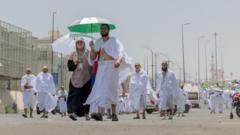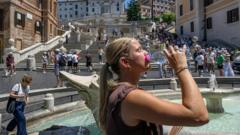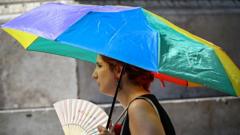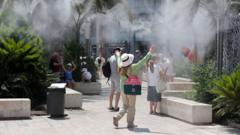In an effort to ensure the safety of pilgrims during the Hajj, which marks a sacred journey in Islam, Saudi Arabia has introduced robust guidelines due to the intense summer heat. Having experienced a tragic loss of approximately 1,300 lives last year, predominantly attributed to soaring temperatures, the Kingdom has heightened its safety measures.
Saudi Arabia Implements Safety Measures as Hajj Pilgrimage Begins Amid Extreme Heat

Saudi Arabia Implements Safety Measures as Hajj Pilgrimage Begins Amid Extreme Heat
As 1.4 million Muslims embark on the Hajj pilgrimage in Mecca, Saudi authorities emphasize safety protocols to prevent heat-related fatalities.
Pilgrims are now urged to adhere to specific precautions as they navigate the holy city of Mecca, where temperatures are projected to hit 44C (111F). The Saudi government has implemented a series of initiatives, including the planting of thousands of trees and the installation of over 400 cooling units to provide respite from the heat.
In addition, authorities have enforced a ban on children under 12 years of age and have issued warnings to unregistered pilgrims attempting to partake in the Hajj without proper documentation, imposing hefty fines and potential entry bans. The decision comes after reports indicated that 80% of last year's fatalities were among unregistered individuals who lacked access to necessary amenities such as air-conditioned accommodations and transportation during the severe heat, which peaked at 51C.
While the Hajj is an essential religious duty for many Muslims, with costs for official packages soaring between $4,000 to $20,000 based on various factors, some pilgrims have resorted to entering Saudi Arabia on tourist visas due to financial constraints.
On the first day of the pilgrimage, men donned two white garments, symbolizing a state of Ihram, while women dressed modestly, covering their heads. Pilgrims commenced their journey at the Grand Mosque, performing rituals that include circling the Kaaba and traveling between the hills of Safa and Marwa.
To combat the heat, the Saudi health ministry has strongly advised attendees to minimize sun exposure during peak hours, utilize umbrellas, and stay hydrated. The Kingdom has expanded shaded areas by 50,000 sq m and enhanced road infrastructures to combat extreme temperatures. Additionally, AI technology will manage crowds through drone monitoring, striving to prevent repeats of past tragedies such as a deadly stampede in 2015.
In addition, authorities have enforced a ban on children under 12 years of age and have issued warnings to unregistered pilgrims attempting to partake in the Hajj without proper documentation, imposing hefty fines and potential entry bans. The decision comes after reports indicated that 80% of last year's fatalities were among unregistered individuals who lacked access to necessary amenities such as air-conditioned accommodations and transportation during the severe heat, which peaked at 51C.
While the Hajj is an essential religious duty for many Muslims, with costs for official packages soaring between $4,000 to $20,000 based on various factors, some pilgrims have resorted to entering Saudi Arabia on tourist visas due to financial constraints.
On the first day of the pilgrimage, men donned two white garments, symbolizing a state of Ihram, while women dressed modestly, covering their heads. Pilgrims commenced their journey at the Grand Mosque, performing rituals that include circling the Kaaba and traveling between the hills of Safa and Marwa.
To combat the heat, the Saudi health ministry has strongly advised attendees to minimize sun exposure during peak hours, utilize umbrellas, and stay hydrated. The Kingdom has expanded shaded areas by 50,000 sq m and enhanced road infrastructures to combat extreme temperatures. Additionally, AI technology will manage crowds through drone monitoring, striving to prevent repeats of past tragedies such as a deadly stampede in 2015.






















